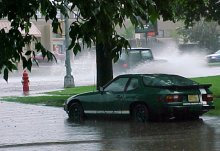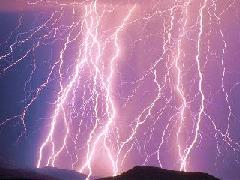Severe Weather: The Most to Least Fatal & the Key Steps to Save Your Life
by SixWise.com
In the United States we're exposed to all kinds of weather -- from
extreme heat to extreme cold, tropical storms and blizzards;
you name it, it happens here. Anyone who's ever had to
drive during a snowstorm or venture outside during a heat
wave knows that weather can be much more than an inconvenience -- it
can be downright dangerous and at times even fatal.
Knowing what to do when severe weather hits, and it will
hit sooner or later, is more than just a smart idea -- it
can actually save your life. The following list of severe
weather is ranked from most to least fatal, and is based on
a 10-year average from 1994 to 2003.
1. Extreme Heat and Humidity
The 10-year average for heat-related fatalities is 237. While
it makes sense to believe that heat-related deaths would usually
occur outdoors, in 2003 44 percent of the deaths occurred
inside the home. The elderly are most at risk from extreme
heat -- those aged 70 and over accounted for 44 percent
of related deaths in 2003 -- along with children and people
who are sick or overweight.
Heat and high humidity are dangerous because the body must
work extremely hard just to maintain a normal temperature.
When a person has been overexposed to heat (or exercised too
heavily), the body can be pushed past its limit.
In the case of heat exhaustion, which occurs when heavy sweating
releases a lot of body fluid, blood flow is sent to the skin
and away from the vital organs. This results in a mild form
of shock that can lead to heat stroke if not treated. Heat
stroke is a life-threatening condition in which the body loses
its ability to control temperature. The body's temperature
may rise so high that it causes brain damage and even death.
What to do during a heat emergency:
-
Stay out of the sun and avoid strenuous work
-
Stay indoors with air conditioning, if possible
-
If no air conditioning is available, stay on the lowest
floor (out of the sun) or go to a public place (like a
library, movie theater or shopping mall) that is air conditioned
-
Drink a lot of water and avoid alcohol
-
Eat light meals
-
Never leave children or pets in vehicles
-
Keep an eye on family and friends who may not have air
conditioning
2. Flood
|

Never try to drive through a flooded road. All it takes
is two feet of water to carry your car away!
|
Floods (including flash floods, river floods and urban/small
stream floods) were responsible for 84 deaths, according to
the 10-year average from the U.S. National Hazard Statistics.
The National Flood Insurance Program defines a flood as, "A
general and temporary condition of partial or complete inundation
of two or more acres of normally dry land area or of two or
more properties from:
... [or the] collapse or subsidence of land along the
shore of a lake or similar body of water as a result of erosion
or undermining caused by waves or currents of water exceeding
anticipated cyclical levels that result in a flood."
Floods are very common (the
recent tsunami disaster is an extreme example), and you
have likely experienced one to some degree after a heavy thunderstorm
or thawing snow. In the event that flood waters are rising,
the Federal Emergency Management Agency (FEMA) recommends
that you:
-
Evacuate your home immediately and turn of utilities
if instructed to do so by authorities
-
Ensure you have a clean water supply (fill up tubs,
sinks and containers with water in case it becomes contaminated)
-
Use a battery-operated radio to hear the latest flood
updates
-
Move to upper floors or even the roof if necessary
-
Wash your hands with soap if you touch any floodwater
(it can contain raw sewage and chemicals)
-
Don't walk or drive through flooded areas (even
six inches of flood water can knock you over and two feet
of water can carry away a car!). According to the U.S.
National Hazard Statistics, 45 percent of flood victims
in 2003 were in vehicles.
-
Stay away from electrical wires
3. Tornado
The U.S. National Hazard Statistics show that tornados resulted
in 58 deaths per year on average. Tornados, which are really
just violent windstorms that take on a twisting, funnel shape,
cause damage with their high winds and ability to scatter
debris. Tornados can occur any time of year, but the season
runs from March through August. Interestingly, you're
not likely to see a tornado in the morning -- over 80 percent
of tornadoes occur between noon and midnight, according to
FEMA.
What to do if a tornado strikes:
-
Move to the lowest level of your home to an interior
room with no windows (a basement is best, but if you don't
have one use an interior bathroom or closet)
-
Move under a heavy piece of furniture like a table and
stay away from windows
-
Cover your head and neck with your arms and hold onto
the furniture you are under
-
If you're in a mall or school, avoid areas with
"wide-span" roofs
-
If you're outside and you can't get indoors,
lie in a ditch or near a sturdy building
-
If you're in a car, get out of the car immediately -- don't
try to out-drive the tornado -- and into a building
or, if necessary, a ditch or low-lying area.
4. Lightning
|

A single bolt of lightning can reach temperatures of
close to 50,000 degrees Fahrenheit and can electrocute
on contact!
|
Lightning resulted in 53 deaths, according to the 10-year
average. The most dangerous places to be if lightning strikes
are in the open, under a tree or in water, as they resulted
in 42 percent, 19 percent and 12 percent of deaths, respectively,
in 2003.
A bolt of lightning can reach temperatures of nearly 50,000
degrees Fahrenheit, so if you sense a thunderstorm is developing
get indoors immediately. In the event you're caught outside:
-
Avoid metal objects like wire fences and golf clubs,
as well as tall isolated trees (these can act like natural
lightning rods)
-
Lightning can strike the same place twice, according
to FEMA, and often does several times during one discharge -- so
don't move to a spot that lightning hit previously
thinking you'll be safe
-
Avoid rivers, lakes and streams
-
If in the woods, seek shelter under a low clump of trees
-
If in a field and your hair stands on end, it means lightning
is about to strike. You should lean forward with your
hands on your knees and crouch (don't lie flat on
the ground).
If you're inside:
-
Avoid electronics, including telephones and TV sets,
as the wires can transmit the lightning
-
Avoid bathtubs, water faucets and sinks because metal
pipes conduct electricity
5. Winter Storm
Winter storms are responsible for 44 deaths each year on
average, according to the U.S. National Hazard Statistics.
Being
in a vehicle is the most dangerous place to be during a winter
storm, as this accounted for 68 percent of related deaths
in 2003.
In the event of a winter storm, FEMA says you should:
-
Stay inside and dress in warm clothes
-
Save fuel
-
Listen to the radio or TV for updates on storm information
-
Dress warmly in loose-fitting layers if you go outside
-
Take frequent breaks while shoveling snow
-
Cover your mouth when outdoors to protect your lungs
from the cold
-
Avoid pushing yourself too hard outdoors, such as while
shoveling, as the weather puts an extra strain on the
heart
-
Watch for signs of frostbite and hypothermia
-
Avoid travel if possible
-
Help out neighbors, friends and family who may need assistance
6. Extreme Cold
Cold temperatures cause 27 deaths a year on average. Seniors
are most at risk -- those between the ages of 70 and 79
accounted for 25 percent of deaths in 2003. The precautions
for extreme cold, which can cause heat to leave your body
rapidly, are the same as those for winter storms (the two
often go hand-in-hand). In addition, according to the Centers
for Disease Control and Prevention (CDC):
Also, don't allow infants to sleep in cold rooms (they
lose body heat much more quickly than adults) and eat well-balanced
meals (they'll help you stay warmer).
7. Hurricane
Tropical storms with winds that reach a constant speed of
74 miles per hour or more, known as hurricanes, cause 18 deaths
per year on average. Hurricane season lasts from June 1 through
November 30, with August and September being peak months.
Hurricanes can bring high winds, torrential rains and storms
to land and sea.
What to do if a hurricane strikes:
-
Evacuate mobile homes immediately
-
Avoid elevators
-
If at home, avoid windows, skylights and glass doors
-
Have flashlights, batteries and other supplies handy
-
Evacuate if necessary, turning off electricity and the
main water valve
-
Avoid flooded roads and washed-out bridges
-
Listen to a battery-operated radio or TV for storm updates
and instructions
Sources
National
Hazard Statistics
FEMA:
Hazards
CDC:
Winter Weather